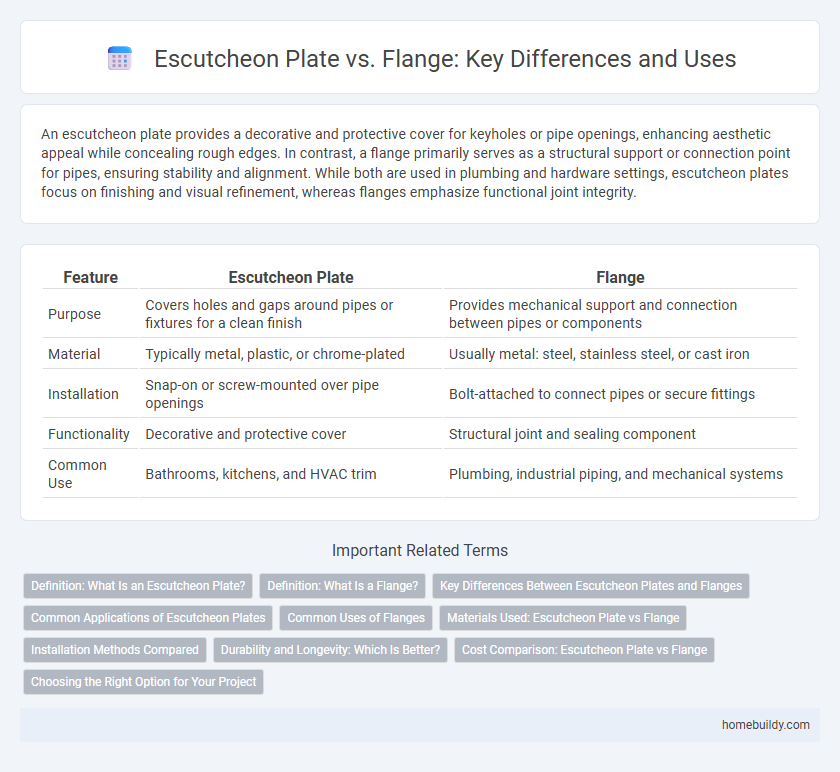An escutcheon plate provides a decorative and protective cover for keyholes or pipe openings, enhancing aesthetic appeal while concealing rough edges. In contrast, a flange primarily serves as a structural support or connection point for pipes, ensuring stability and alignment. While both are used in plumbing and hardware settings, escutcheon plates focus on finishing and visual refinement, whereas flanges emphasize functional joint integrity.
Table of Comparison
| Feature | Escutcheon Plate | Flange |
|---|---|---|
| Purpose | Covers holes and gaps around pipes or fixtures for a clean finish | Provides mechanical support and connection between pipes or components |
| Material | Typically metal, plastic, or chrome-plated | Usually metal: steel, stainless steel, or cast iron |
| Installation | Snap-on or screw-mounted over pipe openings | Bolt-attached to connect pipes or secure fittings |
| Functionality | Decorative and protective cover | Structural joint and sealing component |
| Common Use | Bathrooms, kitchens, and HVAC trim | Plumbing, industrial piping, and mechanical systems |
Definition: What Is an Escutcheon Plate?
An escutcheon plate is a decorative and protective metal or plastic cover that conceals the gap or hole around a pipe or fixture where it passes through a wall or floor, enhancing the installation's aesthetic and providing a clean finish. Unlike a flange, which primarily serves as a structural component to secure pipes or fittings in place and provide a surface for pipe connections, an escutcheon plate focuses on masking imperfections and preventing dust or debris from entering the gap. Escutcheon plates are commonly used in plumbing and HVAC systems to present a polished look while maintaining functionality.
Definition: What Is a Flange?
A flange is a mechanical component used to connect pipes, valves, pumps, and other equipment, providing a secure and leak-proof joint. Unlike an escutcheon plate, which primarily serves as a decorative cover around pipe entries or fixtures, a flange functions as a structural element in piping systems. Flanges are essential for maintenance and assembly, allowing easy disconnection and reattachment of pipe segments.
Key Differences Between Escutcheon Plates and Flanges
Escutcheon plates are decorative covers that conceal pipe holes and provide a finished look, while flanges are mechanical components used to connect pipes or secure them to surfaces. Escutcheon plates are typically thin and designed for aesthetic purposes, whereas flanges are thicker, engineered for structural support and sealing. The primary difference lies in function: escutcheon plates hide gaps, flanges join or stabilize pipe sections.
Common Applications of Escutcheon Plates
Escutcheon plates are commonly used in plumbing and door hardware to cover and protect pipe penetrations or keyholes, providing a clean, finished look while preventing dirt and moisture ingress. Unlike flanges, which often serve as mechanical supports or connection points, escutcheon plates primarily offer aesthetic enhancement and minor protective functions in residential and commercial settings. Typical applications include covering pipe gaps in sinks, bathtubs, and showers, as well as concealing door lock cylinders and hinges.
Common Uses of Flanges
Flanges are commonly used to connect pipes, valves, pumps, and other equipment in plumbing and industrial systems, ensuring a secure and leak-proof joint. Unlike escutcheon plates, which primarily serve a decorative or protective purpose around pipe penetrations, flanges provide structural support and enable easy assembly and disassembly of piping components. Their applications span water supply, gas pipelines, and HVAC systems, where reliable sealing and mechanical strength are critical.
Materials Used: Escutcheon Plate vs Flange
Escutcheon plates are commonly manufactured from stainless steel, brass, or chrome-plated steel, offering corrosion resistance and aesthetic appeal in plumbing or door hardware applications. Flanges, on the other hand, often utilize materials such as cast iron, ductile iron, or carbon steel due to their structural requirements in pipe connections and mechanical support. The choice of material directly impacts durability, functionality, and installation environment suitability for both escutcheon plates and flanges.
Installation Methods Compared
Escutcheon plates are installed by sliding them over the pipe before securing with screws or adhesive, providing a clean finish that hides the hole around the pipe. Flanges typically require mounting directly onto the wall or floor with screws, often necessitating precise alignment to ensure stability and proper sealing. The escutcheon plate installation offers faster application and easier replacement compared to flange installation, which is more permanent and structurally supportive.
Durability and Longevity: Which Is Better?
Escutcheon plates are typically crafted from durable metals like brass or stainless steel, offering superior resistance to corrosion and wear compared to most flanges. Flanges, often made from similar materials, may experience quicker degradation due to exposure at pipe connections and potential seal failures. Therefore, escutcheon plates generally provide enhanced longevity and require less frequent replacement in plumbing and hardware applications.
Cost Comparison: Escutcheon Plate vs Flange
Escutcheon plates generally cost less than flanges due to simpler design and lower manufacturing complexity. Flanges often require more material and precise machining, raising production expenses and installation costs. Choosing an escutcheon plate can reduce overall project budget while maintaining necessary aesthetic and protective functions.
Choosing the Right Option for Your Project
Escutcheon plates provide a sleek, decorative finish that conceals unsightly gaps around pipes or door hardware, making them ideal for aesthetic-focused projects. Flanges offer robust structural support and secure attachment points, suitable for applications requiring enhanced stability and load-bearing capacity. Assess your project's needs by prioritizing appearance versus functionality to select between an escutcheon plate or flange effectively.
escutcheon plate vs flange Infographic

 homebuildy.com
homebuildy.com